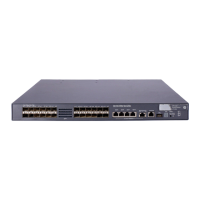85
Configuring PoE
PoE enables a PSE to supply power to PDs from Ethernet interfaces through straight-through twisted pair
cables.
Advantages
• Reliable—Power is supplied in a centralized way so that it is convenient to provide a backup power
supply.
• Easy to connect—A network terminal requires no external power supply except an Ethernet cable.
• Standard—It is in compliance with IEEE 802.3af, and adopts a globally uniform power interface.
• Promising—It can be applied to IP telephones, wireless LAN access points (APs), portable chargers,
card readers, web cameras, and data collectors.
Composition
As shown in Figure 33, a PoE system comprises PoE power, PSE, PI, and PD.
• PoE power—The whole PoE system is powered by the PoE power.
• PSE—A PSE supplies power for PDs. A PSE can be built-in (Endpoint) or external (Midspan). A built-
in PSE is integrated in a switch, and an external PSE is independent from a switch. HP PSEs are built
in. The system uses PSE IDs to identify different PSEs. To display the mapping between a PSE ID and
the member ID of a switch, execute the display poe device command.
NOTE:
The PSE ID is the switch member ID multiplies 3 and then plus 1. For example, if the member ID of the
device is 3, the PSE ID of the device is 3 × 3 + 1 = 10.
A PSE can examine the Ethernet cables connected to PoE interfaces, search for PDs, classify them, and
supply power to them. When detecting that a PD is unplugged, the PSE stops supplying power to the PD.
• PI—An Ethernet interface with the PoE capability is a PoE interface. A PoE interface can be an FE or
GE interface.
• PD—A PD accepts power from the PSE, including IP phones, wireless APs, chargers of portable
devices, POS, and web cameras.
• The PD that is being powered by the PSE can be connected to another power supply unit for
redundancy power backup.
Figure 33 PoE system diagram

